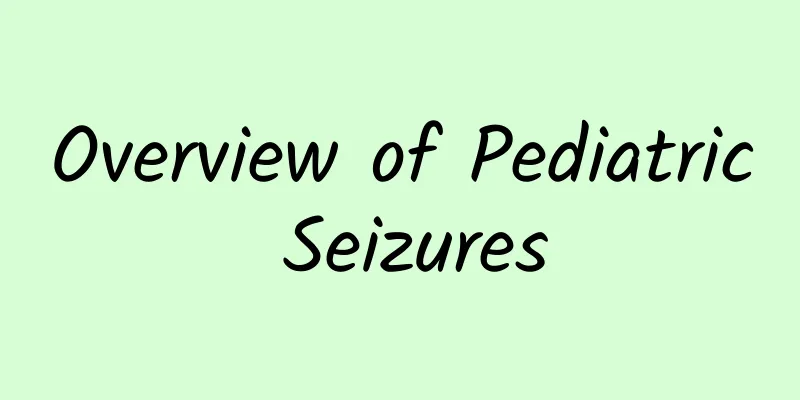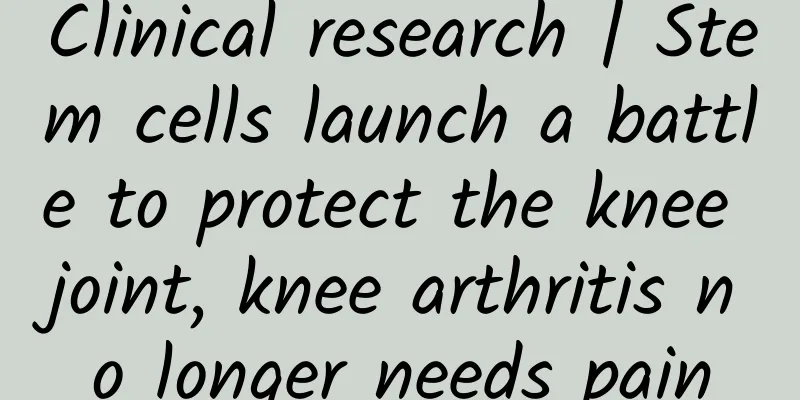Overview of Pediatric Seizures

|
01 Overview of Pediatric Convulsions Febrile convulsions are one of the common neurological diseases in children and the most common cause of convulsions. They cause an imbalance in the excitement and inhibition process in the baby's brain and abnormal discharge of the brain's motor neurons. This disease can cause children to have symptoms such as rigidity, convulsions, binocular strabismus, eyeball roll-up, and loss of consciousness. Pediatric convulsions: commonly known as convulsions, seizures, or twitching, refers to muscle twitching throughout the body or in a part of the body, caused by involuntary and strong contraction of skeletal muscles, often accompanied by staring or squinting, loss of consciousness, and sometimes accompanied by foaming at the mouth or twitching of the corners of the mouth, respiratory arrest, cyanosis of the face, etc. The EEG may be normal or abnormal during an attack. Hypocalcemic convulsions: After the birth of a newborn, the calcium source from the mother suddenly stops, and the blood calcium level begins to drop. The normal concentration of total calcium in the blood is 2.5mmol/L. When the total calcium in the blood is lower than 1.75-2mmol/L or the free calcium is lower than 0.9mmol/L, it is called hypocalcemia, which is one of the important causes of convulsions in the neonatal period. It manifests as congenital rickets in the newborn, hypocalcemic convulsions in the newborn, late teething and uneven teeth in the baby, and can also lead to congenital laryngeal stridor, infant edema, decreased immune function, etc. Hypoglycemic convulsions: In addition to eating milk, children should also add complementary foods according to their age, such as cod liver oil, vitamin B1 and vitamin B6, and various minerals. Children should not be allowed to starve to avoid hypoglycemic convulsions. 02Causes 1. The child’s brain development is not perfect Febrile convulsions are caused by the incomplete development of the child's nervous system. This disease is more common in children between six months and four years old. When a child has a convulsion, there are generally no sequelae. 2. Fever or bacterial infection When the child's body temperature exceeds 38.0℃, it is easy for the child to have a high fever convulsion. If you want to prevent high fever convulsions, you must let the child take antipyretic drugs in time when the child has a high fever. At the same time, when the child's body is inflamed, he or she should also take some anti-inflammatory drugs. This can effectively prevent the child from having a high fever convulsion. 3. Caused by genetic reasons If someone in the family suffers from febrile convulsions, the probability of this type of person suffering from febrile convulsions is much higher than that of ordinary people. Therefore, this type of person should take measures to prevent febrile convulsions in advance, so that they can receive timely treatment when the disease occurs, thereby reducing the occurrence of delayed emergency treatment. 4. Viral infection is an important cause of fever Because children's bodies are not fully developed and their resistance is relatively low, they are more likely to suffer from inflammation, which stimulates the body and causes febrile convulsions. In addition to the above reasons, there are many other causes of febrile convulsions in children. When a child has a febrile convulsion, he must go to the hospital for a comprehensive examination so that the cause of the febrile convulsion can be found and treated accordingly. 03Characteristics of febrile convulsions 1. Stage of onset: The first attack is more common between 6 months and 6 years old, and rarely occurs in children under 6 months and over 6 years old. The peak age for febrile convulsions is 12-18 months old, and 2% to 4% of children under 5 years old may experience febrile convulsions, which is obviously age-related. 2. Regarding body temperature: According to the 2011 American Academy of Pediatrics standards, febrile seizures are seizures that occur under a feverish state (rectal temperature ≥38.5°C, axillary temperature ≥38°C), with no evidence of central nervous system infection or other causes of seizures, and no history of afebrile seizures. 3. Characteristics of convulsions: Convulsions often occur when the temperature rises suddenly. The higher the body temperature, the higher the probability of convulsions. Convulsions mostly occur in the early stage of upper respiratory tract infection. Convulsions are accompanied by impaired consciousness. After the convulsions stop, consciousness quickly recovers and there are no abnormal neurological manifestations. Most children recover well after convulsions, and only a very small number of children may develop epilepsy. 04Clinical classification 1. Simple type It usually occurs between six months and four years old, and rarely after five years old. It is usually caused by acute fever caused by a cold, and convulsions usually occur when the body temperature suddenly rises to 38.5-39.5 degrees Celsius. After a convulsion occurs, the child will show loss of consciousness, symmetrical systemic tonic-clonic spasms, staring or squinting, which lasts for a few seconds or minutes, usually not more than 15 minutes. Consciousness recovers quickly after the attack, and there is no recurrence within 24 hours. 2. Complex The age is usually over 6 years old, the body temperature after convulsion is greater than 38.5 degrees Celsius, the seizure is localized, the convulsion lasts for more than 15 minutes, and the seizure is repeated within 24 hours. This type of child has a poor prognosis, and 1% to 2% of the condition may develop into epilepsy. 3. Febrile status seizure (FSE)** refers to a febrile seizure lasting ≥30 minutes, or repeated seizures with consciousness not restored for 30 minutes or more between seizures. 05Clinical manifestations Febrile convulsions usually occur within 24 hours after fever. Many babies have no signs before the onset of the disease. They often suddenly become unconscious, have their eyes rolled up, have cyanosis of the lips, regurgitate, vomit, foam at the mouth, have rigid limbs, and have whole-body or partial limb convulsions. Severe cases may also cause incontinence of urine and feces. It usually lasts for a few seconds or minutes and then resolves on its own. After the attack, the child is conscious. The body temperature is often above 38.5℃. Usually only one convulsion occurs during a fever, but a few may have two or more convulsions. The severity of the convulsion is not proportional to the body temperature. 06Emergency measures The key is to reduce the fever. When a child has a high fever convulsion, the key is to reduce the fever first. Undress the child to dissipate heat, and cool down physically, such as cold compresses, place cold towels on the forehead, neck, armpits, and groin of the child, or use a cooling patch. Use a warm water towel to gently and repeatedly wipe the areas where large veins run, such as the neck, armpits on both sides, elbows, groin, etc., to make the skin red to facilitate heat dissipation. When a child has a fever, cover him with clothes and quilts, thinking that sweating will reduce the fever. In fact, this will cause the child to be unable to dissipate heat and the high fever will not subside, and even convulsions. Skin care When the child is in the process of cooling down after a high fever, a lot of sweat will be discharged. The sweat should be wiped off and the clothes should be changed in time to prevent cold. Parents stay calm When a child has a convulsion, parents are most likely to panic when they see symptoms such as twitching hands and feet. At this time, they may make mistakes in a hurry and harm the child. Therefore, when a child has a high fever convulsion, parents must not panic and keep themselves calm! Ensure the child's breathing is unobstructed. When a child has a convulsion, they should immediately move to the floor or bed, remove obstacles, unbutton their clothes, collars and belts in turn, and tilt their heads to one side. Clear the secretions from the mouth, nose and throat in time to avoid inhaling secretions and vomit into the trachea to prevent suffocation. Remember not to wrap the child too tightly to avoid blocking the mouth and nose and affecting breathing. Ensure the safety of the child (this measure has different opinions, and various versions have been collected here, depending on the situation) 1. Prevent tongue bite: When children have convulsions, stay away from any hard or sharp objects. Skeletal muscles will involuntarily contract strongly, and they may "bite the tongue". Wrap a spoon with clean gauze and place it between the upper and lower teeth to avoid biting the tongue. There are also studies that show that children will hardly bite their tongues during febrile convulsions, so don't put anything into their mouths or let them bite with your hands. If the teeth are tightly closed, do not pry them open forcibly to avoid damaging the teeth or more serious complications (there have been reports of pen caps, fingers, and falling into the respiratory tract). Therefore, do not fill the mouth too full to avoid hindering the child's breathing and causing suffocation due to lack of oxygen. Therefore, it is of great significance to identify the precursors of convulsions. Febrile convulsions mostly occur during the period of rising body temperature, and in some children they may occur during the period of defervescence. Attention should be paid to whether the child has the following precursors: irritability, frightened expression, sudden increase in muscle tension in the limbs, rapid, paused or irregular breathing, etc. Soft cloth can be placed between the upper and lower teeth of the child in advance to avoid injury to the oral mucosa and gums during convulsions. 2. Prevent fractures: Never forcefully restrain the limbs of children with convulsions to avoid fractures. Acupressure refers to pressing the Ren Zhong, Hegu, supraorbital, Yongquan, etc. acupoints, which have the effect of stopping convulsions, but attention should be paid to the strength and be careful not to cause local injuries. If too much force is used when pinching Ren Zhong, it will cause local skin damage or loose teeth. It is strictly forbidden to eat when convulsions occur. When the child's condition occurs, parents should not feed the child water or food, otherwise it is easy for water or food to enter the child's airway, causing suffocation or inflammation. At the same time, keep the environment quiet to prevent the child from being stimulated and causing repeated convulsions. Do a good job of oral care. After the child has a high fever, the saliva secretion will decrease, resulting in dry oral and tongue mucosa. If there is food residue in the mouth at this time, the oral environment is conducive to the reproduction of bacteria, resulting in gingivitis and glossitis in the child; the child's oral care should be done well to maintain oral hygiene. Nutritional support: High fever convulsions lead to increased catabolism, increased consumption of protein, fat and vitamins in the body, and a large loss of water. After the child wakes up, high-calorie, high-vitamin, high-protein and other foods should be given. Seek medical attention promptly. If the child has not returned to normal within 3-5 minutes, or has repeated attacks in a short period of time, it is likely that the child's condition is more serious. In this case, he must be sent to the hospital for treatment in time to prevent accidents. Oxygen should be supplied and vital signs should be monitored as soon as possible. Once a convulsion occurs, the child's brain will generally be deprived of oxygen. At the same time, their respiratory system cannot work normally in a convulsive state, which will further aggravate the hypoxia and easily cause edema in the child's brain, which will worsen the convulsion symptoms again and eventually lead to a vicious cycle. Therefore, it is crucial to supply oxygen as soon as possible, and take cooling measures such as antipyretics as soon as possible to lower the child's body temperature. Monitor the patient's vital signs comprehensively, and deal with any abnormalities in a timely manner to avoid unnecessary occurrences. Use medication for treatment 1. Medication for cooling down. Generally, oral antipyretics, such as Motrin, Tylenol, etc., or antipyretic suppositories can be used. Giving antipyretic medication to children with low fever can easily lead to adverse reactions in children, such as hypothermia or heavy sweating, leading to shock. If the seizure lasts for 5 minutes, medication should be used to stop it as soon as possible. 2. Intravenous injection of diazepam is simple, fast, safe and effective, and is a first-line anticonvulsant. 0.3-0.5mg/Kg is injected slowly intravenously at a rate of <1ml/min. It can also be injected intramuscularly (use with caution in infants under 6 months old, as improper use may cause respiratory depression). 3. If it is difficult to establish intravenous access immediately, midazolam can be injected intramuscularly; 10% chloral hydrate 0.4-0.6ml/Kg, retention enema can also achieve satisfactory anticonvulsant effect; **For FSE cases, intravenous medication is required to actively stop convulsions, and the post-ictal status is closely monitored, fever is actively reduced, and the causes of fever and convulsions are found and treated. 4. Indications for intermittent preventive treatment: ① Frequent convulsive attacks in a short period of time (≥3 times within 6 months or ≥4 times within 2 years); or ② Status convulsus occurs, and anticonvulsant drugs are required to stop the attack. Intermittent oral administration of adequate doses of diazepam, clonazepam or chloral hydrate enema during the initial stage of febrile illness can mostly effectively prevent convulsions; there are reports that intermittent use of the new anti-epileptic drug levetiracetam can prevent the recurrence of febrile convulsions. 07 First aid procedures for febrile seizures 08 Four pictures to understand the treatment of febrile convulsions 09Precautions 1. Strengthen physical exercise and enhance children's immunity. Open windows frequently for ventilation indoors and let children go outdoors more often to allow the body to adapt to the environment and reduce the occurrence of infectious diseases. When the weather changes, pay attention to adding clothes to prevent upper respiratory tract infections. 2. Pay attention to balanced nutrition. In addition to eating milk, children should also add complementary foods according to their age, such as cod liver oil, calcium tablets, vitamin B1 and vitamin B6, and various minerals. Children should not be allowed to starve to avoid hypocalcium and hypoglycemia convulsions. 3. Follow the doctor's advice and use medicines reasonably to prevent children from accidentally taking toxic drugs. If a child has a history of convulsions, pay special attention to the child's temperature changes and take antipyretics in time if fever occurs. When the temperature is above 38℃, active fever reduction should be carried out. The methods are: warm water sponge bath: the water temperature should be slightly higher than the body temperature, mainly sponge bath the neck, armpits, popliteal fossa, groin and other places where large veins run, pay attention to the time, and at the same time, use a cold water wet towel to apply a large area on the forehead to reduce the temperature of the head and protect the brain; you can also take oral or intramuscular sedatives under the guidance of a doctor to prevent the recurrence of convulsions. 4. Guardians should strengthen their care to prevent children from hitting their heads and causing brain trauma, and should not hit their heads at will. If the cause of the child's convulsions has been diagnosed, we should strictly follow the doctor's instructions to take good care of the child and take relevant medicines on time. |
<<: International Hug Day丨Why does a loving hug stimulate our “tactile pleasure”?
>>: Not only cervical spondylosis can cause nausea and vomiting, this eye disease can also!
Recommend
Conization of cervical erosion
Conization of cervical erosion is a treatment met...
Causes of irregular menstruation after childbirth
Many female friends find that their menstruation ...
I heard that drinking coffee can cause osteoporosis?
This is the 4499th article of Da Yi Xiao Hu In th...
Five principles for preventing ectopic pregnancy
The so-called ectopic pregnancy refers to the imp...
How to treat closed comedones in girls quickly
Closed comedones are a relatively common type of ...
Can I eat before amniocentesis?
The most important thing about amniocentesis is t...
Do girls need to wear bras when steaming?
You all know that sauna clubs outside are general...
How many days does the egg live in the body?
Generally speaking, girls ovulate about 14 days b...
Eight months pregnant fetus diagram
During pregnancy, as the fetus gradually grows, w...
Why is 2020 a strange year? What disasters did the Martian boy predict in 2020?
I thought 2020 would be a good year, but I never ...
TechInsights: The global smartphone market is expected to return to low single-digit growth in 2024
According to recent news, the performance of smar...
Common symptoms of cervical insufficiency
Being able to have a healthy baby is the dream of...
Autism is knowable and treatable
"Doctor, my three-year-old child still can&#...
Is it normal to have a headache after sweating for a full moon?
After sweating for a full month, mothers will exp...
What are some ways to exercise for women to lose weight?
I believe that having a well-proportioned and sle...









